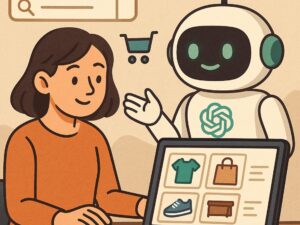
Blog
The eCommerce Disruptor: Buying Products Directly from AI Assistants like ChatGPT
24th Jul, 2025
There’s been a lot of noise in the last week about OpenAI’s relationship with Shopify, and it’s very likely that in the near future people will not only be using AI interfaces to search for products, they will also be using it to buy those products, too.
OpenAI is currently working with partners like Shopify, Instacart, Expedia and others to allow AI users to take actions like placing orders or booking travel through plugins or integrated tools, rather than just researching these products and experiences and then having to move to a different platform to buy them.
Amazon and other large platforms are following suit, and heavily investing in AI shopping assistants to reflect this experience.
These developments are likely to create a massive disruption in the way eCommerce works, and how people buy products online.
Conversational Commerce
Conversational commerce is the practice of buying and selling products through natural, real-time dialogue, often via AI chatbots, voice assistants, or messaging platforms, rather than through traditional eCommerce interfaces like websites or apps.
Unlike traditional commerce, which relies on search bars, filters, and static product pages, conversational commerce creates a dynamic, personalised shopping experience where users can ask questions, get tailored product recommendations, and complete purchases all within a single conversation – it’s like having a personal shopper and friendly product expert in your pocket.
This paradigm shift is happening because consumers increasingly value speed, convenience, and personalisation. Over the years, technology has made us impatient, and raised our expectations of what to expect from our shopping experiences.
As AI becomes more capable of understanding intent, context, and preferences, people are gravitating toward more intuitive, hands-free ways to shop, especially on mobile devices and smart home assistants.
At the same time, rising expectations for seamless digital experiences are pushing brands to meet customers where they are, which increasingly means inside chat-based and voice-first environments.
Creating Native Shopping Experiences
Conversational commerce has created a need for ‘native shopping experiences’ which allow users to browse, compare, and purchase products, experiences, or services directly within the platform they’re using, like ChatGPT or a social media app like TikTok, without needing to visit an external website or search engine.
AI companies are now focusing on providing this functionality because it streamlines the buying process, reduces friction for users, and keeps people engaged within a single environment – making conversions more likely.
For customers, this provides convenience, speed, and personalised shopping recommendations powered by real-time data and behaviour analysis.
For businesses and platforms, it creates new revenue streams, has the potential to boost conversion rates, and could even strengthen control over the user journey.
As online behaviour continues to shift toward ‘conversational’ search, AI-driven native shopping is the natural next step in the evolution of ecommerce.
Voice and Multimodal Shopping
Voice and multimodal shopping (where users interact with AI using voice commands, visuals, and text at the same time) is probably going to disrupt traditional eCommerce by making product discovery and purchasing faster, more intuitive, more accessible, and deeply personalised.
Instead of typing into a search bar, which can sometimes be a protracted and frustrating process, users can simply speak to an AI assistant and see curated results, images, reviews, and videos instantly in response.
This hands-free, conversational approach reduces friction and even decision fatigue, especially on mobile or smart devices because people can chat through options with AI, thus making the research and decision process much more natural.
As voice interfaces become more accurate and visual responses more immersive, traditional product listing pages and search-based browsing may feel outdated, especially to younger generations.
The shift empowers consumers to shop in a more natural, interactive way, turning eCommerce from a task into a conversation.
The Impact of eCommerce Changes on Paid Media
If the buying journey becomes more conversational, contextual, and controlled by AI interfaces, platforms like Google and Meta may lose some of their dominance in eCommerce advertising unless they adapt quickly to these new customer behaviours.
There will potentially be fewer traditional searches on Google and other search engines. While Google is still incredibly dominant today, as users begin to get used to asking AI assistants for product recommendations directly, they may start to bypass Google Search or social platforms entirely. This will reduce the volume of high-intent search queries that advertisers rely on and means that marketers will need to diversify their advertising campaigns to reach users on the right platforms.
This is actually quite exciting for paid media marketers, because there will most likely be new advertising environments for us to explore. Platforms like ChatGPT, Amazon’s Alexa, and Apple’s Siri are in the process of becoming the new shop ‘front doors’ for online users.
This change is creating pressure on traditional ad platforms, as brands look to invest in AI-native ad placements, product integrations, or sponsored responses inside chat interfaces.
We’re all very used to scrolling on social media and seeing products on those platforms to buy; however, as younger generations especially start to switch allegiance from TikTok and Instagram to AI for their product recommendations, they are going to expect that these platforms also offer them the opportunity to buy seamlessly.
If people start making purchases based on a single AI conversation rather than browsing social media for inspiration, the value of social ads, especially those aimed at product discovery, may need to evolve into richer, more AI-compatible formats. Again – another exciting opportunity for paid media teams to develop and adapt their campaigns to this brave new world of eCommerce.
The Future of eCommerce and AI Shopping
The rise of AI-powered shopping experiences clearly marks a fundamental paradigm shift in how consumers discover, engage with, and purchase products online.
From conversational commerce and native shopping to voice and multimodal interactions, the eCommerce journey is becoming more intuitive, seamless, and deeply personalised, replacing traditional product searches and static listings with real-time dialogue and tailored recommendations.
As AI assistants like ChatGPT evolve into the new digital storefronts, the ripple effects will be felt across the entire digital landscape, especially in paid media.
For brands and marketers, this is not a threat, but an opportunity: to reimagine the customer journey, explore new ad formats, and meet users where they are, inside the conversation.
The future of eCommerce isn’t just about clicks and conversions; it’s about building intelligent, responsive experiences that feel less like shopping and more like having a trusted friend and expert shopper by your side at all times.







